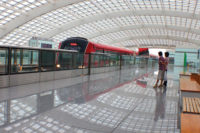
A logical progression for physical security is the migration to IP node devices. In an IP world there is little difference between an intercom, a camera and a card reader (voice, video and data), according to Stephen Pineau, CEO of VSI Viscount.
Security Magazine:What are the economics driving change?
Pineau:Since the 1980s, access control panels have been used to process card readers and manage inputs and outputs. Control panels consume up to 80% of the cost of card access installations so there are basic economic reasons for both reader suppliers and end-users to support change. New IP and Edge readers are now poised to forever change how card access systems are installed and managed. IP readers eliminate the need for separate control equipment and additional savings come from replacing proprietary cabling with standard network cabling. Direct reader to server connectivity can also enhance security by allowing more powerful and encrypted reader data to be processed and simplify logical/physical convergence.
Security Magazine:How is IP driving this architecture?
Pineau:While physical/logical security convergence has become very topical, the emergence of Internet Protocol (IP) for the enterprise convergence of voice, video and data is also disrupting traditional security hardware. If we look at physical security devices in enterprise terms (voice = intercom, video = CCTV and data = card access/alarm) we can see why IP devices will radically alter the concept of what constitutes a physical security system. IP cameras for video and VoIP for intercom are already making an impact. Now, with the introduction of the Edge IP product line from HID, the card access industry is reaching a tipping point. While traditional suppliers struggle to come up with IP solutions for their panels, the next generation IP readers and software solutions may render these efforts pointless.
Security Magazine:What is the new reader architecture?
Pineau:IP readers provide device based control, run on standard IT networks and using WEB management software provide the control functions of panels at a fraction of the cost. They can be installed on any LAN, WAN or wireless network. Like IP cameras, they can be managed from anywhere in the world. Unlike IP cameras, IP readers require very little bandwidth and will have little impact on networks. We expect to see an array of IP devices including both RFID and biometric.
Security Magazine:How are IP readers managed?
Pineau:IP readers are managed in a similar way to network video solutions, which include camera management software, analytics and drivers for various brands of cameras. IP and network based access control systems will include a database of users, permissions, and schedules as well as drivers for various suppliers of IP access control devices. IP readers are more easily managed through a Web management tool than IP cameras since issues such as frame rates don’t apply.

Mesh servers will play a more important role is security systems design.
Pineau:IP-based readers will have the ability to operate in a degraded mode if networks fail and have the ability to employ high availability measures not typical with control panels. When end-users consider the overall cost and technological benefits of the new architecture the concerns put forth by control panel suppliers should evaporate.
Security Magazine:Will IP devices help smartcard and biometric deployments?
Pineau:The evolution of biometrics and smartcards, particularly the U.S. Government’s HSPD-12 initiative, has exacerbated the data limit problems of control panels. Direct IP reader to server connections allow powerful and encrypted smartcard formats to be processed, rather than the Wiegand conversion typically required of panels and provide advanced smartcard features such as read/write. For biometrics, panel format limitations have created a mishmash of onboard reader databases or separate wiring and management systems for programming. The net result of these and other issues is a control panel architecture that is difficult to install and manage and provides more of an appearance of increased security than actual increased security.
Security Magazine:What is the future of the IP devices?
Pineau:A logical progression for physical security is the migration to IP node devices. In an IP world there is little difference between an intercom, a camera, and a card reader (voice, video and data). The only difference is the type of data. Each IP node will have a function or set of functions. IP cameras already have speaker/mic functions for voice (video/voice). We could also see intercom/card readers (voice/data) and camera/card readers (video/data) etc. In addition each IP node will have an assortment input and output relays. Finally, we will see IP nodes dedicated to specific requirements for inputs and outputs such as elevator control.
Security Magazine:What are universal management tools?
Pineau:End-users often desire integrated graphic user interfaces for video, access control, intercom, fire alarm, HVAC and other building management systems. With proprietary hardware and software this has been very difficult. The evolution of these various industry groups to IP node devices with WEB management tools dramatically improves long term opportunities for end- users to achieve their integration goals. This points to another coming battleground, the development of universal IP node management systems which are independent of application, be it video, card access or automation.
